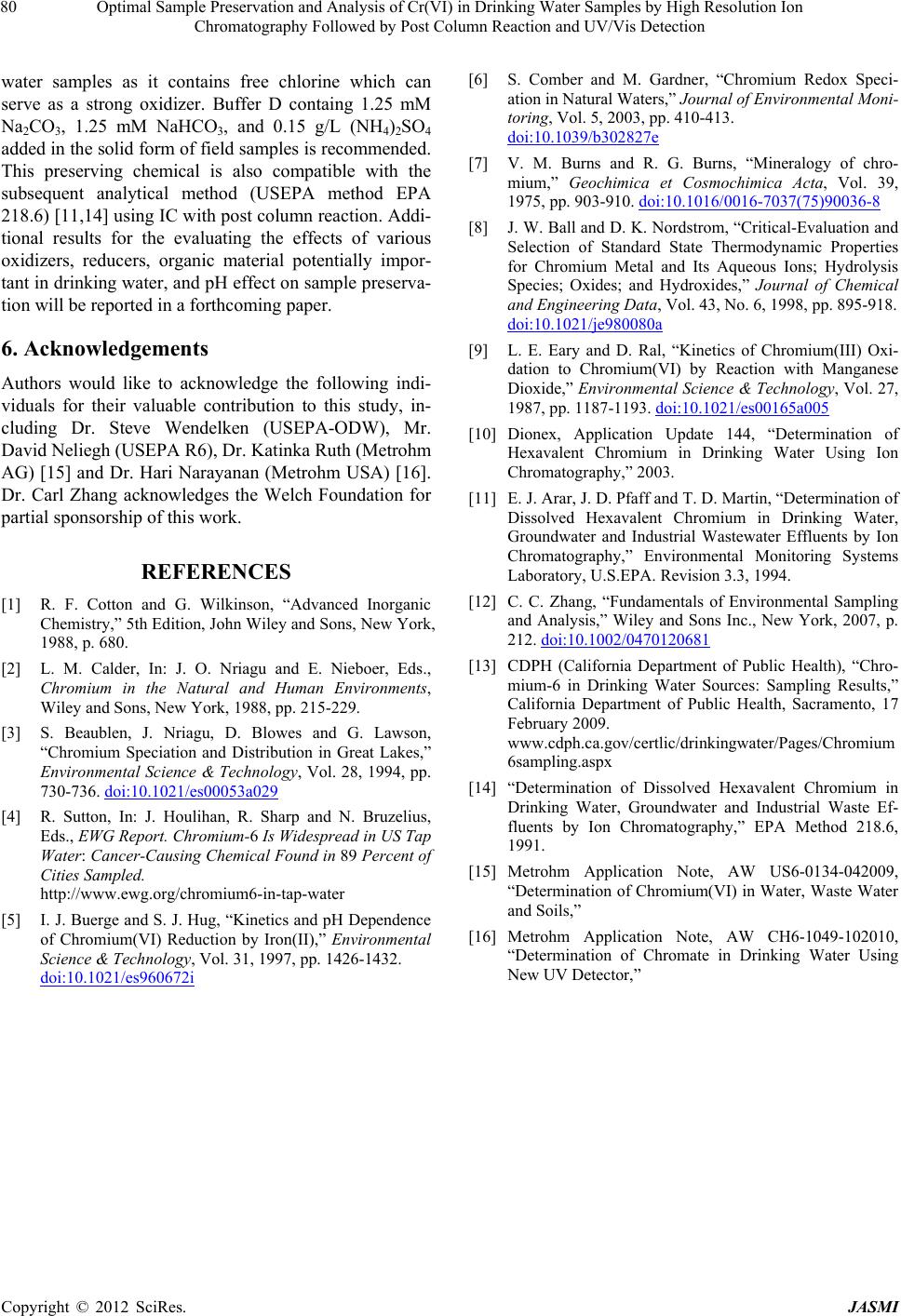
Optimal Sample Preservation and Analysis of Cr(VI) in Drinking Water Samples by High Resolution Ion
Chromatography Followed by Post Column Reaction and UV/Vis Detection
Copyright © 2012 SciRes. JASMI
80
water samples as it contains free chlorine which can
serve as a strong oxidizer. Buffer D containg 1.25 mM
Na2CO3, 1.25 mM NaHCO3, and 0.15 g/L (NH4)2SO4
added in the solid form of field samples is recommended.
This preserving chemical is also compatible with the
subsequent analytical method (USEPA method EPA
218.6) [11,14] using IC with post column reaction. Addi-
tional results for the evaluating the effects of various
oxidizers, reducers, organic material potentially impor-
tant in drinking water, and pH effect on sample preserva-
tion will be reported in a forthcoming paper.
6. Acknowledgements
Authors would like to acknowledge the following indi-
viduals for their valuable contribution to this study, in-
cluding Dr. Steve Wendelken (USEPA-ODW), Mr.
David Neliegh (USEPA R6), Dr. Katinka Ruth (Metrohm
AG) [15] and Dr. Hari Narayanan (Metrohm USA) [16].
Dr. Carl Zhang acknowledges the Welch Foundation for
partial sponsorship of this work.
REFERENCES
[1] R. F. Cotton and G. Wilkinson, “Advanced Inorganic
Chemistry,” 5th Edition, John Wiley and Sons, New York,
1988, p. 680.
[2] L. M. Calder, In: J. O. Nriagu and E. Nieboer, Eds.,
Chromium in the Natural and Human Environments,
Wiley and Sons, New York, 1988, pp. 215-229.
[3] S. Beaublen, J. Nriagu, D. Blowes and G. Lawson,
“Chromium Speciation and Distribution in Great Lakes,”
Environmental Science & Technology, Vol. 28, 1994, pp.
730-736. doi:10.1021/es00053a029
[4] R. Sutton, In: J. Houlihan, R. Sharp and N. Bruzelius,
Eds., EWG Report. Chromium-6 Is Widespread in US Tap
Water: Cancer-Causing Chemical Found in 89 Percent of
Cities Sampled.
http://www.ewg.org/chromium6-in-tap-water
[5] I. J. Buerge and S. J. Hug, “Kinetics and pH Dependence
of Chromium(VI) Reduction by Iron(II),” Environmental
Science & Technology, Vol. 31, 1997, pp. 1426-1432.
doi:10.1021/es960672i
[6] S. Comber and M. Gardner, “Chromium Redox Speci-
ation in Natural Waters,” Journal of Environmental Moni-
toring, Vol. 5, 2003, pp. 410-413.
doi:10.1039/b302827e
[7] V. M. Burns and R. G. Burns, “Mineralogy of chro-
mium,” Geochimica et Cosmochimica Acta, Vol. 39,
1975, pp. 903-910. doi:10.1016/0016-7037(75)90036-8
[8] J. W. Ball and D. K. Nordstrom, “Critical-Evaluation and
Selection of Standard State Thermodynamic Properties
for Chromium Metal and Its Aqueous Ions; Hydrolysis
Species; Oxides; and Hydroxides,” Journal of Chemical
and Engineering Data, Vol. 43, No. 6, 1998, pp. 895-918.
doi:10.1021/je980080a
[9] L. E. Eary and D. Ral, “Kinetics of Chromium(III) Oxi-
dation to Chromium(VI) by Reaction with Manganese
Dioxide,” Environmental Science & Technology, Vol. 27,
1987, pp. 1187-1193. doi:10.1021/es00165a005
[10] Dionex, Application Update 144, “Determination of
Hexavalent Chromium in Drinking Water Using Ion
Chromatography,” 2003.
[11] E. J. Arar, J. D. Pfaff and T. D. Martin, “Determination of
Dissolved Hexavalent Chromium in Drinking Water,
Groundwater and Industrial Wastewater Effluents by Ion
Chromatography,” Environmental Monitoring Systems
Laboratory, U.S.EPA. Revision 3.3, 1994.
[12] C. C. Zhang, “Fundamentals of Environmental Sampling
and Analysis,” Wiley and Sons Inc., New York, 2007, p.
212. doi:10.1002/0470120681
[13] CDPH (California Department of Public Health), “Chro-
mium-6 in Drinking Water Sources: Sampling Results,”
California Department of Public Health, Sacramento, 17
February 2009.
www.cdph.ca.gov/certlic/drinkingwater/Pages/Chromium
6sampling.aspx
[14] “Determination of Dissolved Hexavalent Chromium in
Drinking Water, Groundwater and Industrial Waste Ef-
fluents by Ion Chromatography,” EPA Method 218.6,
1991.
[15] Metrohm Application Note, AW US6-0134-042009,
“Determination of Chromium(VI) in Water, Waste Water
and Soils,”
[16] Metrohm Application Note, AW CH6-1049-102010,
“Determination of Chromate in Drinking Water Using
New UV Detector,”